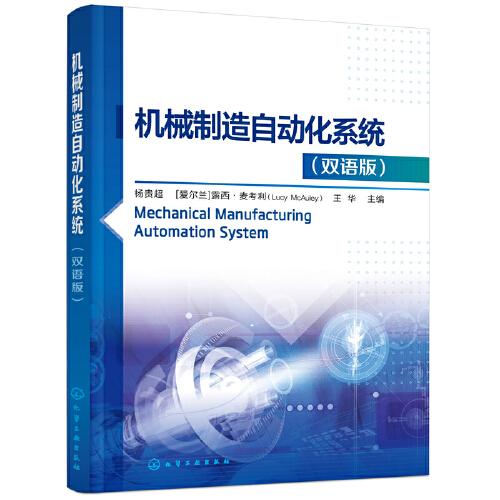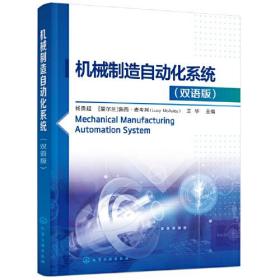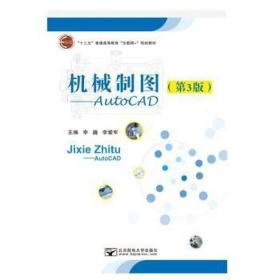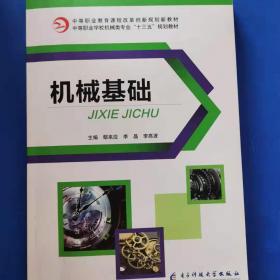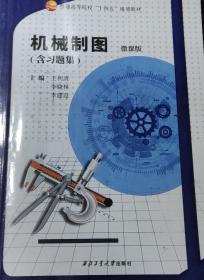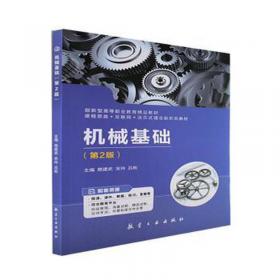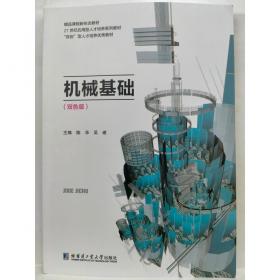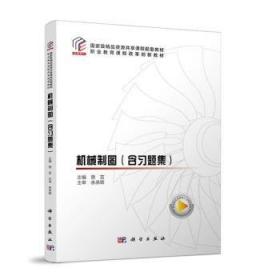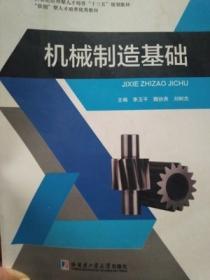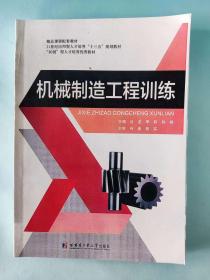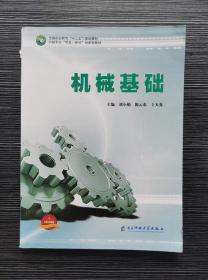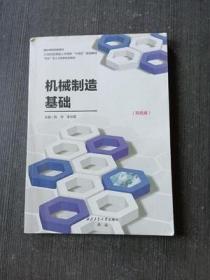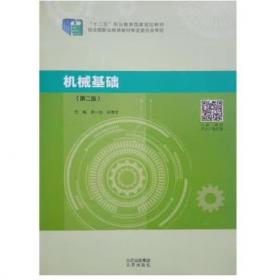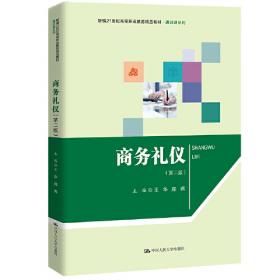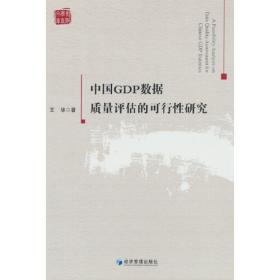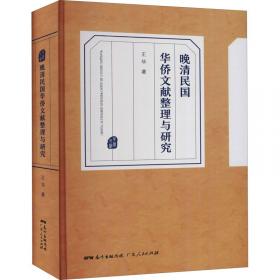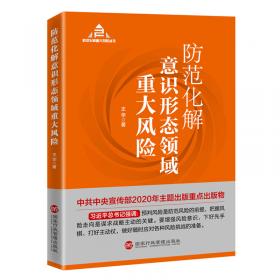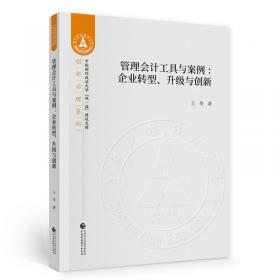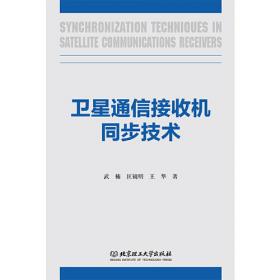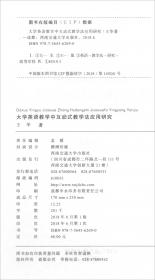机械制造自动化系统(双语版)(杨贵超)
出版时间:
2021-06
版次:
1
ISBN:
9787122381316
定价:
48.00
装帧:
平装
开本:
16开
纸张:
胶版纸
页数:
165页
字数:
264千字
-
本书从机械制造自动化的基本概念出发,围绕机械制造的各个生产环节,系统地介绍了各个环节实现自动化的原理、技术、方法和实际应用。全书共分九章,主要介绍了工业自动化、气动学、可编程逻辑控制器(PLC)、 逻辑系统和PLC编程、 顺序控制、PID控制、机器人、视觉、数控技术等方面的内容。本书可作为高等工科院校机械设计制造及其自动化、机械工程、工业工程等机械类专业的教材,也可供从事机械设计与制造、自动化等相关专业的企业工程技术人员自学和参考。
王华,大学,教授,20142015年美国麻省大学amhert分校访问学者。 Chapter 1 Introduction of Industrial Automation/1
第1章 工业自动化简介/1
1.1Pneumatics and Electropneumatics/1
1.1气动学和电气学/1
1.2Programmable Logic Controller/2
1.2可编程逻辑控制器/2
1.3Robotics/2
1.3机器人学/2
1.4Machine Vision/3
1.4机器视觉/3
Chapter 2 Pneumatics/5
第2章 气动学/5
2.1Pneumatics Overview/5
2.1气动学概述/5
2.2Production of Compressed Air/6
2.2压缩空气的产生/6
2.3Components of a Pneumatic System/7
2.3气动系统的组成/7
2.3.1Air Service Unit/8
2.3.1气源装置/8
2.3.2Pneumatic Actuator/8
2.3.2气动执行器/8
2.3.3Directional Control Valve/10
2.3.3方向控制阀/10
2.3.4Flow Control Valve/12
2.3.4流量控制阀/12
2.3.5Pneumatic Circuit Diagram/13
2.3.5气动回路图/13
2.4Electropneumatic System Component/14
2.4电气系统元件/14
2.4.1Solenoid/14
2.4.1螺线管/14
2.4.2Switch /15
2.4.2开关/15
2.4.3Sensor/17
2.4.3传感器/17
2.4.4Relay/20
2.4.4继电器/20
2.5Design of Electropneumatic Circuit/20
2.5电气电路的设计/20
2.6Latch Circuit/24
2.6锁存电路/24
2.7Step Diagram/26
2.7阶跃图/26
Chapter 3 Programmable Logic Controller/27
第3章 可编程逻辑控制器/27
3.1Construction/28
3.1构造/28
3.2Memory/29
3.2内存/29
3.2.1Memory Type/29
3.2.1内存类型/29
3.2.2Memory Map/30
3.2.2内存映射/30
3.3Memory Element/30
3.3存储元件/30
3.4Operation of the PLC/32
3.4PLC的运行/32
3.4.1PLC Operating System/33
3.4.1PLC操作系统/33
3.4.2Program Execution/33
3.4.2程序执行/33
3.4.3I/O Imaging/34
3.4.3I/O成像/34
3.4.4Cyclic Scanning/36
3.4.4循环扫描/36
3.5Input/Output(I/O)Module/37
3.5输入/输出(I/O)模块/37
3.5.1Input Module/39
3.5.1输入模块/39
3.5.2Output Module/39
3.5.2输出模块/39
3.6Address List and Wiring Diagram/40
3.6地址表和接线图/40
Chapter 4 Logic System and PLC Programming/42
第4章 逻辑系统和PLC编程/42
4.1Logic Circuit/42
4.1逻辑电路/42
4.1.1AND Gate/42
4.1.1与门/42
4.1.2OR Gate/44
4.1.2或门/44
4.1.3NOT Gate/45
4.1.3非门/45
4.1.4NAND Gate/45
4.1.4与非门/45
4.1.5NOR Gate/46
4.1.5或非门/46
4.1.6XOR Gate/46
4.1.6异或门/46
4.2Input and Output/47
4.2输入和输出/47
4.3Programming Language/48
4.3编程语言/48
4.3.1Ladder Diagram/48
4.3.1梯形图/48
4.3.2Instructional List Program/50
4.3.2程序指令列表/50
4.4Latch/52
4.4锁存器/52
4.5Counter/54
4.5计数器/54
4.6Timer/55
4.6定时器/55
Chapter 5 Sequential Control/57
第5章 顺序控制/57
5.1The Expressions of Automation Process/57
5.1自动过程的表达方式/57
5.1.1Relay Ladders and Logic Schematic/58
5.1.1继电器梯形图和逻辑示意图/58
5.1.2Flow Diagram/58
5.1.2流程图/58
5.1.3Function Diagram/58
5.1.3功能图/58
5.2Sequential Function Diagram/58
5.2顺序功能图/58
5.3Sequential Programming/60
5.3顺序程序设计/60
5.3.1Shift Register/61
5.3.1移位寄存器/61
5.3.2Programming a Shift Register/61
5.3.2移位寄存器的编程/61
5.4Example of Shift Register Programming/62
5.4移位寄存器编程实例/62
Chapter 6 PID Control/65
第6章 PID控制/65
6.1Introduction of PID Control/65
6.1PID控制简介/65
6.2Proportional Control/67
6.2比例控制/67
6.3Proportional-integral Control/69
6.3比例-积分控制/69
6.4Proportional-derivative Control/71
6.4比例-微分控制/71
6.5Proportional-integral-derivative Control/73
6.5比例-积分-微分控制/73
6.6The Parameter Tuning of the PID Controller /74
6.6PID控制器的参数整定/74
6.6.1The Physical Meaning of the PID Parameters/74
6.6.1PID参数的物理意义/74
6.6.2The Method of PID Parameter Tuning/79
6.6.2PID的参数整定方法/79
Chapter 7 Robot/96
第7章 机器人/96
7.1Introduction of Robot/96
7.1机器人简介/96
7.1.1Brief History of Robot/96
7.1.1机器人简史/96
7.1.2Definition of Robot/97
7.1.2机器人的定义/97
7.2Key Components of Industrial Robot/98
7.2工业机器人的关键部件/98
7.2.1Robot Arm/98
7.2.1机械臂/98
7.2.2Controller/99
7.2.2控制器/99
7.2.3Teach Pendant/101
7.2.3示教器/101
7.2.4Monitor/Terminal/101
7.2.4监视器/终端/101
7.3Robot Specification/102
7.3机器人规格/102
7.4Programming in V /103
7.4V 编程/103
7.5Flow Diagram/106
7.5流程图/106
7.6Robot Program/106
7.6机器人程序/106
Chapter 8 Vision System/111
第8章 视觉系统/111
8.1Introduction of Vision System/111
8.1视觉系统简介/111
8.1.1Uses of Vision Systems/112
8.1.1视觉系统的用途/112
8.1.2Outputs of Vision Systems/112
8.1.2视觉系统的输出/112
8.1.3Components of Vision System/112
8.1.3视觉系统的组成/112
8.2Image Acquisition/113
8.2图像采集/113
8.2.1Light Source/113
8.2.1光源/113
8.2.2Camera/115
8.2.2相机/115
8.3Image Processing/116
8.3图像处理/116
8.3.1Image Digitization/116
8.3.1图像数字化/116
8.3.2Stages of Image Processing/118
8.3.2图像处理的步骤/118
8.4Data Obtain and Process/125
8.4数据获取及处理/125
8.5Typical Vision System Algorithm Process/125
8.5典型视觉系统算法过程/125
8.6Vision Limitation/126
8.6视觉局限性/126
8.7Vision Calibration/126
8.7视觉校准/126
8.8Image Processing in Matlab /126
8.8Matlab图像处理/126
Chapter 9 Numerical Control Technique/128
第9章 数控技术/128
9.1Introduction of CNC Machine Tool/128
9.1数控机床简介/128
9.1.1Definition of CNC Machine Tool/128
9.1.1数控机床的定义/128
9.1.2Composition of CNC Machine Tool/129
9.1.2数控机床的组成/129
9.1.3Working Principle of CNC Machine Tool/132
9.1.3数控机床加工的工作原理/132
9.1.4Features of CNC Machining/132
9.1.4数控加工的特点/132
9.1.5Classification of CNC Machine Tool/134
9.1.5数控机床分类/134
9.2Fundamentals of CNC Machine Tool Programming/138
9.2数控机床编程基础/138
9.2.1Basic Concept of CNC Programming/138
9.2.1数控编程的基本概念/138
9.2.2Steps of CNC Programming/138
9.2.2数控程序编制的步骤/138
9.2.3The Method of CNC Programming/140
9.2.3数控程序编制的方法/140
9.2.4CNC Machine Tool Coordinate System/141
9.2.4数控机床坐标系/141
9.2.5NC Program Format/144
9.2.5数控加工程序格式/144
9.2.6Program Segment Function Word/145
9.2.6程序段功能字/145
9.2.7NC Programming/148
9.2.7数控程序编制/148
9.3CNC Interpolation Principle/153
9.3数控插补原理/153
9.3.1CNC Interpolation Overview/153
9.3.1数控插补概述/153
9.3.2Linear Interpolation with Point by point Comparison Method/154
9.3.2逐点比较法直线插补/154
9.4Key Performance Indexes of CNC Machine Tool/159
9.4数控机床的主要性能指标/159
9.4.1Main Technical Specifications/159
9.4.1主要技术规格/159
9.4.2Motion Index/159
9.4.2运动指标/159
9.4.3Precision Index/160
9.4.3精度指标/160
9.4.4Tool System/161
9.4.4刀具系统/161
9.4.5Other Indexes/161
9.4.5其他指标/161
9.5Development of the NC Technology/161
9.5数控技术发展/161
References/165
参考文献/165
-
内容简介:
本书从机械制造自动化的基本概念出发,围绕机械制造的各个生产环节,系统地介绍了各个环节实现自动化的原理、技术、方法和实际应用。全书共分九章,主要介绍了工业自动化、气动学、可编程逻辑控制器(PLC)、 逻辑系统和PLC编程、 顺序控制、PID控制、机器人、视觉、数控技术等方面的内容。本书可作为高等工科院校机械设计制造及其自动化、机械工程、工业工程等机械类专业的教材,也可供从事机械设计与制造、自动化等相关专业的企业工程技术人员自学和参考。
-
作者简介:
王华,大学,教授,20142015年美国麻省大学amhert分校访问学者。
-
目录:
Chapter 1 Introduction of Industrial Automation/1
第1章 工业自动化简介/1
1.1Pneumatics and Electropneumatics/1
1.1气动学和电气学/1
1.2Programmable Logic Controller/2
1.2可编程逻辑控制器/2
1.3Robotics/2
1.3机器人学/2
1.4Machine Vision/3
1.4机器视觉/3
Chapter 2 Pneumatics/5
第2章 气动学/5
2.1Pneumatics Overview/5
2.1气动学概述/5
2.2Production of Compressed Air/6
2.2压缩空气的产生/6
2.3Components of a Pneumatic System/7
2.3气动系统的组成/7
2.3.1Air Service Unit/8
2.3.1气源装置/8
2.3.2Pneumatic Actuator/8
2.3.2气动执行器/8
2.3.3Directional Control Valve/10
2.3.3方向控制阀/10
2.3.4Flow Control Valve/12
2.3.4流量控制阀/12
2.3.5Pneumatic Circuit Diagram/13
2.3.5气动回路图/13
2.4Electropneumatic System Component/14
2.4电气系统元件/14
2.4.1Solenoid/14
2.4.1螺线管/14
2.4.2Switch /15
2.4.2开关/15
2.4.3Sensor/17
2.4.3传感器/17
2.4.4Relay/20
2.4.4继电器/20
2.5Design of Electropneumatic Circuit/20
2.5电气电路的设计/20
2.6Latch Circuit/24
2.6锁存电路/24
2.7Step Diagram/26
2.7阶跃图/26
Chapter 3 Programmable Logic Controller/27
第3章 可编程逻辑控制器/27
3.1Construction/28
3.1构造/28
3.2Memory/29
3.2内存/29
3.2.1Memory Type/29
3.2.1内存类型/29
3.2.2Memory Map/30
3.2.2内存映射/30
3.3Memory Element/30
3.3存储元件/30
3.4Operation of the PLC/32
3.4PLC的运行/32
3.4.1PLC Operating System/33
3.4.1PLC操作系统/33
3.4.2Program Execution/33
3.4.2程序执行/33
3.4.3I/O Imaging/34
3.4.3I/O成像/34
3.4.4Cyclic Scanning/36
3.4.4循环扫描/36
3.5Input/Output(I/O)Module/37
3.5输入/输出(I/O)模块/37
3.5.1Input Module/39
3.5.1输入模块/39
3.5.2Output Module/39
3.5.2输出模块/39
3.6Address List and Wiring Diagram/40
3.6地址表和接线图/40
Chapter 4 Logic System and PLC Programming/42
第4章 逻辑系统和PLC编程/42
4.1Logic Circuit/42
4.1逻辑电路/42
4.1.1AND Gate/42
4.1.1与门/42
4.1.2OR Gate/44
4.1.2或门/44
4.1.3NOT Gate/45
4.1.3非门/45
4.1.4NAND Gate/45
4.1.4与非门/45
4.1.5NOR Gate/46
4.1.5或非门/46
4.1.6XOR Gate/46
4.1.6异或门/46
4.2Input and Output/47
4.2输入和输出/47
4.3Programming Language/48
4.3编程语言/48
4.3.1Ladder Diagram/48
4.3.1梯形图/48
4.3.2Instructional List Program/50
4.3.2程序指令列表/50
4.4Latch/52
4.4锁存器/52
4.5Counter/54
4.5计数器/54
4.6Timer/55
4.6定时器/55
Chapter 5 Sequential Control/57
第5章 顺序控制/57
5.1The Expressions of Automation Process/57
5.1自动过程的表达方式/57
5.1.1Relay Ladders and Logic Schematic/58
5.1.1继电器梯形图和逻辑示意图/58
5.1.2Flow Diagram/58
5.1.2流程图/58
5.1.3Function Diagram/58
5.1.3功能图/58
5.2Sequential Function Diagram/58
5.2顺序功能图/58
5.3Sequential Programming/60
5.3顺序程序设计/60
5.3.1Shift Register/61
5.3.1移位寄存器/61
5.3.2Programming a Shift Register/61
5.3.2移位寄存器的编程/61
5.4Example of Shift Register Programming/62
5.4移位寄存器编程实例/62
Chapter 6 PID Control/65
第6章 PID控制/65
6.1Introduction of PID Control/65
6.1PID控制简介/65
6.2Proportional Control/67
6.2比例控制/67
6.3Proportional-integral Control/69
6.3比例-积分控制/69
6.4Proportional-derivative Control/71
6.4比例-微分控制/71
6.5Proportional-integral-derivative Control/73
6.5比例-积分-微分控制/73
6.6The Parameter Tuning of the PID Controller /74
6.6PID控制器的参数整定/74
6.6.1The Physical Meaning of the PID Parameters/74
6.6.1PID参数的物理意义/74
6.6.2The Method of PID Parameter Tuning/79
6.6.2PID的参数整定方法/79
Chapter 7 Robot/96
第7章 机器人/96
7.1Introduction of Robot/96
7.1机器人简介/96
7.1.1Brief History of Robot/96
7.1.1机器人简史/96
7.1.2Definition of Robot/97
7.1.2机器人的定义/97
7.2Key Components of Industrial Robot/98
7.2工业机器人的关键部件/98
7.2.1Robot Arm/98
7.2.1机械臂/98
7.2.2Controller/99
7.2.2控制器/99
7.2.3Teach Pendant/101
7.2.3示教器/101
7.2.4Monitor/Terminal/101
7.2.4监视器/终端/101
7.3Robot Specification/102
7.3机器人规格/102
7.4Programming in V /103
7.4V 编程/103
7.5Flow Diagram/106
7.5流程图/106
7.6Robot Program/106
7.6机器人程序/106
Chapter 8 Vision System/111
第8章 视觉系统/111
8.1Introduction of Vision System/111
8.1视觉系统简介/111
8.1.1Uses of Vision Systems/112
8.1.1视觉系统的用途/112
8.1.2Outputs of Vision Systems/112
8.1.2视觉系统的输出/112
8.1.3Components of Vision System/112
8.1.3视觉系统的组成/112
8.2Image Acquisition/113
8.2图像采集/113
8.2.1Light Source/113
8.2.1光源/113
8.2.2Camera/115
8.2.2相机/115
8.3Image Processing/116
8.3图像处理/116
8.3.1Image Digitization/116
8.3.1图像数字化/116
8.3.2Stages of Image Processing/118
8.3.2图像处理的步骤/118
8.4Data Obtain and Process/125
8.4数据获取及处理/125
8.5Typical Vision System Algorithm Process/125
8.5典型视觉系统算法过程/125
8.6Vision Limitation/126
8.6视觉局限性/126
8.7Vision Calibration/126
8.7视觉校准/126
8.8Image Processing in Matlab /126
8.8Matlab图像处理/126
Chapter 9 Numerical Control Technique/128
第9章 数控技术/128
9.1Introduction of CNC Machine Tool/128
9.1数控机床简介/128
9.1.1Definition of CNC Machine Tool/128
9.1.1数控机床的定义/128
9.1.2Composition of CNC Machine Tool/129
9.1.2数控机床的组成/129
9.1.3Working Principle of CNC Machine Tool/132
9.1.3数控机床加工的工作原理/132
9.1.4Features of CNC Machining/132
9.1.4数控加工的特点/132
9.1.5Classification of CNC Machine Tool/134
9.1.5数控机床分类/134
9.2Fundamentals of CNC Machine Tool Programming/138
9.2数控机床编程基础/138
9.2.1Basic Concept of CNC Programming/138
9.2.1数控编程的基本概念/138
9.2.2Steps of CNC Programming/138
9.2.2数控程序编制的步骤/138
9.2.3The Method of CNC Programming/140
9.2.3数控程序编制的方法/140
9.2.4CNC Machine Tool Coordinate System/141
9.2.4数控机床坐标系/141
9.2.5NC Program Format/144
9.2.5数控加工程序格式/144
9.2.6Program Segment Function Word/145
9.2.6程序段功能字/145
9.2.7NC Programming/148
9.2.7数控程序编制/148
9.3CNC Interpolation Principle/153
9.3数控插补原理/153
9.3.1CNC Interpolation Overview/153
9.3.1数控插补概述/153
9.3.2Linear Interpolation with Point by point Comparison Method/154
9.3.2逐点比较法直线插补/154
9.4Key Performance Indexes of CNC Machine Tool/159
9.4数控机床的主要性能指标/159
9.4.1Main Technical Specifications/159
9.4.1主要技术规格/159
9.4.2Motion Index/159
9.4.2运动指标/159
9.4.3Precision Index/160
9.4.3精度指标/160
9.4.4Tool System/161
9.4.4刀具系统/161
9.4.5Other Indexes/161
9.4.5其他指标/161
9.5Development of the NC Technology/161
9.5数控技术发展/161
References/165
参考文献/165
查看详情
-
 2
2
全新
广东省广州市
平均发货17小时
成功完成率93.93%
-
全新
广东省广州市
平均发货17小时
成功完成率94.55%
-
全新
广东省广州市
平均发货17小时
成功完成率95.86%
-
全新
广东省广州市
平均发货17小时
成功完成率96.22%
-
全新
河北省保定市
平均发货29小时
成功完成率88.2%
-
 2
2
全新
广东省广州市
平均发货17小时
成功完成率94.22%
-
全新
河北省保定市
平均发货25小时
成功完成率82.69%
-
全新
北京市海淀区
平均发货9小时
成功完成率83.13%
-
全新
江苏省南京市
平均发货9小时
成功完成率90.47%
-
全新
湖北省武汉市
平均发货12小时
成功完成率90.2%
-
全新
江苏省南京市
平均发货15小时
成功完成率81.27%
-
八五品
山东省枣庄市
平均发货8小时
成功完成率92.72%
-
八五品
山东省枣庄市
平均发货8小时
成功完成率91.08%
-
全新
河北省保定市
平均发货26小时
成功完成率84.96%
-
全新
北京市房山区
平均发货20小时
成功完成率93.75%
-
全新
天津市河东区
平均发货21小时
成功完成率90.42%
-
全新
江苏省无锡市
平均发货14小时
成功完成率91.63%
-
全新
天津市西青区
平均发货15小时
成功完成率92.48%
-
全新
北京市东城区
平均发货9小时
成功完成率95.47%
-
全新
广东省东莞市
平均发货16小时
成功完成率83.04%
-
全新
江苏省无锡市
平均发货7小时
成功完成率95.35%
-
 4
4
全新
河北省保定市
平均发货32小时
成功完成率72.96%
-
 2
2
全新
河北省保定市
平均发货32小时
成功完成率69.92%
-
全新
北京市朝阳区
平均发货15小时
成功完成率94.66%
-
全新
北京市朝阳区
平均发货15小时
成功完成率92.72%
-
 5
5
全新
北京市丰台区
平均发货27小时
成功完成率83.31%
-
八五品
山东省济南市
平均发货8小时
成功完成率91.4%
-
全新
河北省保定市
平均发货27小时
成功完成率86.52%
-
八五品
山东省滨州市
平均发货9小时
成功完成率93.02%
-
全新
北京市房山区
平均发货30小时
成功完成率82.54%
-
全新
江西省南昌市
平均发货19小时
成功完成率85.18%
-
八五品
江西省南昌市
平均发货10小时
成功完成率91.8%
-
八五品
江西省南昌市
平均发货11小时
成功完成率90.62%
-
全新
河北省保定市
平均发货25小时
成功完成率80.82%
-
全新
广东省广州市
平均发货15小时
成功完成率86.54%
-
全新
湖南省长沙市
平均发货29小时
成功完成率86.4%
-
全新
河北省保定市
平均发货27小时
成功完成率87.67%
-
 2
2
全新
浙江省嘉兴市
平均发货9小时
成功完成率93.23%
-
 2
2
全新
广东省广州市
平均发货8小时
成功完成率91.92%
-
 2
2
机械制造自动化系统(双语版)
①全新正版,现货速发,7天无理由退换货②天津、成都、无锡、广东等多仓就近发货,订单最迟48小时内发出③无法指定快递④可开电子发票,不清楚的请咨询客服。
全新
-
 2
2
全新
北京市西城区
平均发货22小时
成功完成率90.75%
-
全新
四川省成都市
平均发货19小时
成功完成率87.23%
-
全新
北京市西城区
平均发货18小时
成功完成率92.6%
-
全新
四川省成都市
平均发货15小时
成功完成率78.74%
-
全新
四川省成都市
平均发货15小时
成功完成率78.74%
-
全新
四川省成都市
平均发货15小时
成功完成率78.74%
-
全新
广东省广州市
平均发货10小时
成功完成率93.9%
-
九五品
上海市黄浦区
平均发货27小时
成功完成率84.62%
-
八五品
湖北省孝感市
平均发货7小时
成功完成率91.32%
-
全新
天津市津南区
平均发货14小时
成功完成率85.74%

 占位居中
占位居中

